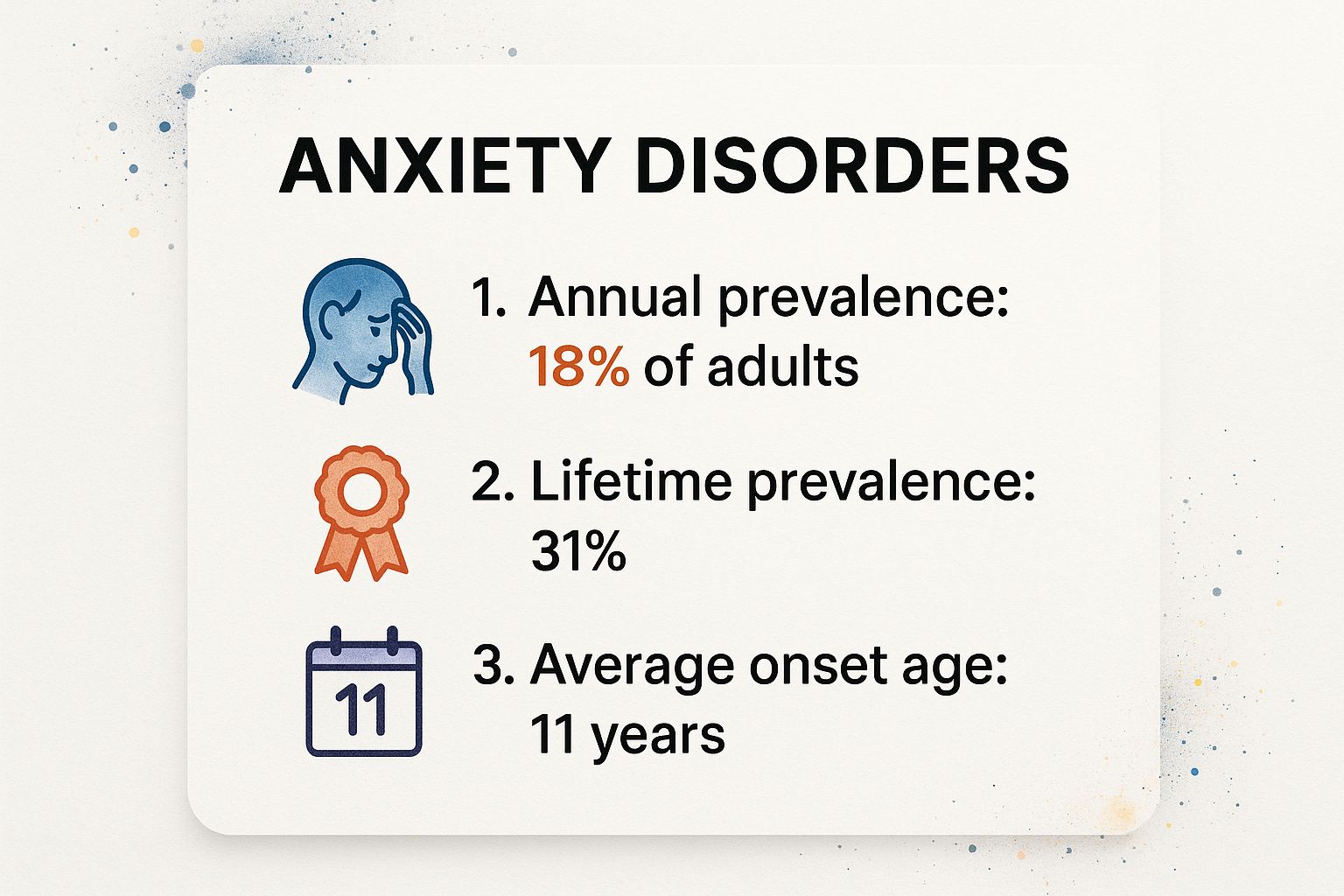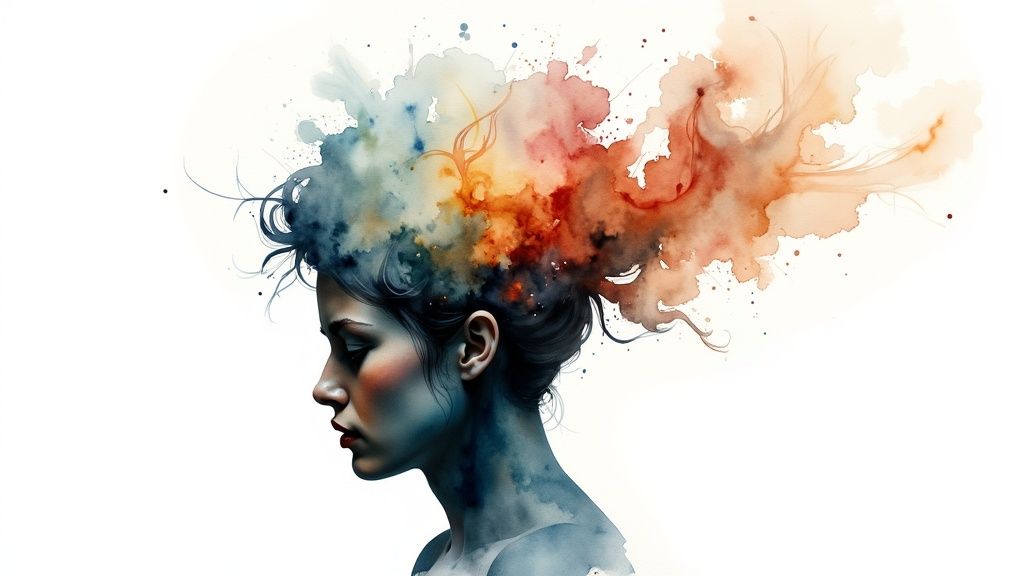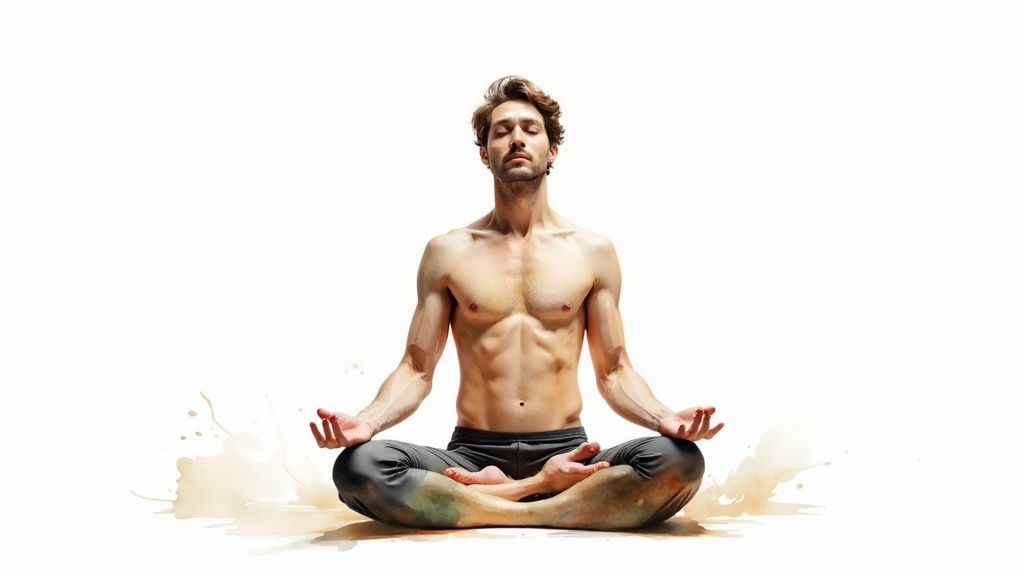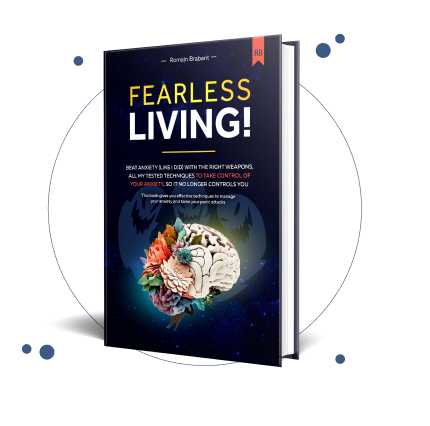
That constant feeling of unease, a racing heart, and the endless "what-if" thoughts… it could be more than just everyday stress. The first real step in figuring out if you have anxiety is recognizing when that persistent, overwhelming worry starts to disrupt your daily life. It’s different from a temporary reaction to a specific stressor.
It’s about learning to spot the signs and, more importantly, realizing there's a clear path toward healing and living a life free from panic.
Learning to Recognize the Signs of Anxiety
If you're here asking, "how do I know if I have anxiety?" you’ve already taken the most important step: you’re seeking clarity. It’s a journey that starts with understanding, and the most crucial insight is that you are not alone. There is immense hope for recovery. So many people walk this path, often feeling isolated by their symptoms without realizing just how common their experience is and how possible it is to heal.
This infographic shows just how widespread anxiety is, highlighting its prevalence and the average age it begins to show up.

The numbers make one thing clear: anxiety affects a huge portion of the population, often starting at a young age. This isn't a personal failing; it's a shared human experience with a well-trodden path to recovery.
Moving from Uncertainty to Understanding
Anxiety isn't just one single feeling. It's a complex mix of physical sensations, emotional states, and thought patterns that can feel like your mind is constantly scanning for threats, even when everything is objectively fine.
You might live with a persistent sense of dread or find yourself avoiding social situations you once looked forward to. These feelings are not just "in your head." They are real, valid, and a core part of how anxiety shows up.
The constant worry can be completely exhausting, making it hard to concentrate at work or be truly present with the people you love. Recognizing these patterns is the beginning of reclaiming your peace of mind and starting your journey to a calmer life.
A Message of Hope: Recovery from anxiety isn't about becoming someone who never worries. It's about learning the skills to manage worry so it no longer controls your decisions, your emotions, or your life. A calm, panic-free existence is not a distant dream—it is an achievable reality.
It's easy to mistake the signs of an anxiety disorder for the stress that comes with a busy life. But there are key differences in how they feel and how long they last.
This table can help you tell them apart:
Anxiety Symptoms vs Everyday Stress
| Symptom Area | Everyday Stress | Potential Anxiety |
|---|---|---|
| Trigger | Caused by a specific, identifiable stressor (e.g., a work deadline, a big decision). | Often feels free-floating or disproportionate to the situation; may occur without a clear trigger. |
| Duration | Temporary; subsides once the stressful situation is resolved. | Persistent and ongoing; can last for weeks, months, or longer, even when things are calm. |
| Intensity | Worry is manageable and related to the specific issue at hand. | Worry is excessive, often uncontrollable, and feels overwhelming. |
| Impact on Life | May cause temporary distraction but doesn't usually prevent daily activities. | Significantly interferes with work, school, relationships, and social life. Avoidance is common. |
| Physical Signs | Occasional tension, headaches, or sleep trouble tied to the stressor. | Chronic physical symptoms like a racing heart, muscle aches, digestive issues, and fatigue. |
Seeing your experience reflected in the "Potential Anxiety" column doesn't mean you have a disorder, but it's a strong sign that what you're feeling is more than just run-of-the-mill stress—and that there are specific, effective ways to heal.
You Are Not Alone in This
Globally, anxiety disorders are the most common mental health challenges. Back in 2019, they affected an estimated 301 million people, which is about 4% of the world's population. These conditions often involve intense, excessive fear that gets in the way of work, school, and relationships, with symptoms frequently starting in childhood or the teen years.
This global prevalence drives home a powerful truth: countless others have felt what you're feeling right now and have found their way to a calmer life. There are proven strategies and pathways to help you navigate this and live panic-free.
For a structured approach to learning these coping mechanisms, our Anxiety University offers comprehensive resources to guide your healing journey. Embracing these tools is a powerful step toward a brighter, more peaceful future.
How Anxiety Shows Up in Your Body
Ever asked yourself, "How do I know if I have anxiety?" The answer often lies beyond your thoughts and worries. Anxiety isn't just a mental battle; it’s a full-body experience. The physical sensations it kicks up are real, often confusing, and a vital clue to understanding what you’re going through.
More importantly, recognizing these signs is a huge step toward healing. It’s the proof you need that what you're feeling is real, manageable, and that a life free from panic is absolutely possible.

Most of us are familiar with the classic signs, like a pounding heart or sweaty palms before a big presentation. But when anxiety becomes chronic, it digs in deeper, creating symptoms that are far more subtle and disruptive.
These physical feelings are usually the fallout from your body’s 'fight or flight' response being stuck in the "on" position. This ancient survival wiring floods your system with stress hormones like adrenaline and cortisol, prepping you to face a threat. When this system stays fired up without a real danger in sight, it starts to take a serious physical toll. The good news is that you can learn to switch it off.
Beyond the Racing Heart
While a rapid pulse is a well-known anxiety symptom, the body has a whole toolkit for signaling distress. These signs can easily be mistaken for other medical issues, which only leads to more confusion and, you guessed it, more worry.
Think about these less obvious, yet incredibly common, physical flags:
- Digestive Distress: That 'anxious stomach' is no joke. It can manifest as nausea, cramps, bloating, or even sudden urges to use the bathroom. The gut-brain axis is a powerful two-way street; mental distress often triggers a very physical reaction in your digestive system.
- Unexplained Aches and Pains: Do your shoulders and neck always feel like they're made of concrete? Persistent muscle tension is a hallmark of chronic anxiety, as your body is constantly braced for a threat that never arrives. This can lead to nagging tension headaches and generalized body aches.
- Chronic Fatigue: This isn't just feeling tired. It's a bone-deep exhaustion that a full night's sleep can't seem to touch. Living in a state of high alert is draining, plain and simple. It burns through your physical and mental energy reserves.
- Dizziness and Lightheadedness: Those sudden, scary moments of feeling off-balance or dizzy are often tied to anxiety-driven changes in your breathing patterns and blood pressure.
Learning to regulate your breathing is one of the most direct ways to calm these physical symptoms down. For a step-by-step guide, check out these powerful breathing exercises for anxiety that can offer immediate relief.
The physical symptoms of anxiety are not "all in your head." They are real physiological responses to a state of chronic stress. Validating this is the first step toward finding relief and understanding that you can heal.
Putting It All Together: A Real-World Scenario
Picture someone named Alex. For months, they’ve just felt physically "off." They wake up tired no matter how much they sleep, their stomach is always in knots, and a dull headache has become their constant companion. They’ve even been to the doctor, but all the tests come back normal, which is frustrating.
Alex feels perpetually on edge, physically drained, and jumpy. A car backfiring makes their heart pound, and they get a wave of dizziness in a crowded grocery store. These are the physical whispers of anxiety—signals from a body that has been stuck in high-alert mode for way too long.
If you see your own story in Alex’s, that can be a moment of true clarity. These aren't just random, unrelated issues. They’re a cluster of symptoms pointing toward underlying anxiety. Making that connection is incredibly empowering. It takes you from a place of mystery and fear to a path with clear, actionable steps toward feeling better. There is tremendous hope, and a panic-free life is absolutely within your reach.
How Anxiety Influences Your Thoughts and Feelings
Anxiety is so much more than just the physical stuff we’ve talked about. It's a powerful force that can completely reshape your thoughts and feelings, often trapping you in a cycle of worry that feels impossible to break.
If you're trying to figure out if what you're experiencing is anxiety, paying close attention to your inner world is just as crucial as noticing a racing heart.
But here's the most important thing to remember: identifying these patterns isn't a reason to feel hopeless. It's actually the first, most powerful step you can take toward reclaiming your mind. It’s proof that a life free from constant worry is entirely possible.

When anxiety takes the driver's seat, it often feels like you just can't "turn off" your brain. This mental overdrive isn't random; it shows up in very specific and draining thought patterns.
The Mental Traps of Anxiety
Take a second and see if any of these internal experiences feel familiar. Recognizing them is the key to understanding the cognitive side of anxiety and finally starting your journey toward healing.
- Catastrophic Thinking: This is the brain's tendency to immediately jump to the absolute worst-case scenario. A friend doesn't text back, and your mind doesn't just think "they're busy"—it leaps to "They're furious with me," or "Something terrible must have happened." A tiny mistake at work feels like it will inevitably lead to you getting fired.
- Persistent Rumination: I call this the mental hamster wheel. You might find yourself obsessively replaying a simple conversation from days ago, dissecting every single word. Or maybe you're constantly churning over everyday decisions, long after they've been made. It's an exhausting and totally unproductive loop.
- Constant "What-If" Scenarios: Your brain becomes a prediction machine for every possible negative outcome. "What if I get sick on vacation?" "What if I completely fail this test?" "What if I say the wrong thing at the party and everyone thinks I'm an idiot?" This constant future-tripping keeps you from ever really being in the present moment.
These thought patterns aren’t just fleeting worries. Over time, they become the default setting for your mind, keeping you in a constant state of high alert. But here's the hopeful truth: you can learn to challenge and change these defaults.
Empowerment Through Awareness: Simply recognizing these thought patterns is your first victory. You can’t change what you don’t acknowledge. By just noticing, "Oh, there's that catastrophic thinking again," you create a tiny bit of space between yourself and the thought. That space is where you get your power back.
The Emotional Fallout
All that nonstop mental chatter has a profound emotional impact. It's not just about "feeling worried"—it’s about living in a state of emotional chaos that can feel incredibly isolating.
This can easily lead to:
- Persistent Irritability: When your nervous system is constantly on high alert, your patience wears thin. Suddenly, small annoyances feel like major provocations. You might find yourself snapping at loved ones or getting intensely frustrated over things that wouldn't normally bother you.
- A Sense of Impending Dread: This is a vague but heavy feeling that something bad is about to happen, even when there's no logical reason for it. It's like living under a dark cloud you just can't seem to shake, no matter how sunny the day is.
- Feeling Emotionally Overwhelmed: Your capacity to handle the normal emotional ups and downs of life just shrinks. A simple request from your boss might feel like an impossible demand. You might find yourself on the verge of tears or feeling completely overwhelmed by even minor stressors.
If this emotional landscape feels like your home right now, please know there is so much hope. These feelings are the direct result of an overactive anxiety response, not a personal failing on your part.
By learning to calm the underlying anxiety, you absolutely can restore your emotional balance and find your way back to a place of peace and joy. A panic-free life is within your reach.
Putting a Name to Your Anxiety
Realizing what you're feeling might be anxiety is a big first step. But the real game-changer? Understanding that "anxiety" isn't just one thing. It's more like a catch-all term, kind of like saying "the weather." That could mean anything from a light drizzle to a full-blown hurricane.
When you start to pin down the specific type of anxiety you're experiencing, something powerful happens. It's not about slapping a label on yourself for the sake of it. It’s about empowerment. It validates your feelings and, more importantly, it shines a light on a clear, recognized path forward. This is the key to finding the right kind of help and realizing that a life free from panic isn't just a hopeful thought—it's completely achievable.
Finding Your Experience in the Patterns
While anxiety shows up in countless ways, a few common patterns tend to emerge. Seeing if your own experience fits one of these doesn't put you in a box. Instead, it shows you that you’re not alone and that others have walked this exact path and found relief.
- Generalized Anxiety Disorder (GAD): People often describe this as a constant, "free-floating" worry that can latch onto almost anything—your job, your health, your family, or just the thought of making it through the day. It’s less about a sudden, sharp spike of fear and more of a persistent, low-grade hum of dread that makes relaxing feel impossible. Catastrophic thinking becomes your default setting.
- Panic Disorder: This is a whole different beast from the steady worry of GAD. Panic disorder is defined by sudden, overwhelming waves of pure terror, known as panic attacks. These episodes can be so intense they feel like a heart attack or like you’re completely losing your mind, and they often come with terrifying physical symptoms that seem to strike from out of nowhere. The fear of the next attack can become a huge source of anxiety all on its own.
- Social Anxiety: This is so much more than just being shy. It's a powerful, gut-wrenching fear of being judged, scrutinized, or humiliated in social settings. This can turn everyday things, like making a phone call or speaking up in a meeting, into deeply threatening events, which often leads people to avoid them altogether.
Getting familiar with these patterns can be incredibly validating. You can dive deeper into a more detailed overview of the different types of anxiety disorders to see how they're officially defined.
The most powerful realization you can have is this: Your specific experience of anxiety has been seen, studied, and understood. This means there are targeted, effective strategies designed to help you heal and regain your peace.
A Struggle That's Both Global and Personal
If you're dealing with anxiety, it's easy to feel isolated. But the truth is, this is a global issue. Research shows that anxiety disorders have clear patterns all over the world, with a significant increase noted after 2019.
Anxiety is especially dominant for adolescents aged 10-14 and tends to peak at different ages depending on a country's socioeconomic landscape. These aren't just statistics; they're proof that you are part of a massive, worldwide community, not some isolated case.
Ultimately, giving your experience a name transforms it. It stops being this big, scary, unknown monster and becomes a defined challenge. And every defined challenge has a solution. This is your starting point for finding the right tools and support to build a future where you are in control—not the anxiety. A panic-free life is absolutely within your grasp.
Your Action Plan for Hope and Healing
Recognizing the patterns of anxiety is a monumental step. But what you do next is what truly matters. This is where we shift from just understanding your anxiety to taking real, meaningful action against it.
The most empowering truth about anxiety is that a life free from its constant grip isn’t just some hopeful dream—it's an attainable reality. You can start building a personalized toolkit for healing and finding calm, starting right now. The journey to a panic-free life begins with small, manageable actions that build momentum and restore your confidence.

Immediate Steps for Finding Calm
When you feel overwhelmed, having a few go-to strategies can make an enormous difference. Think of these not as cures, but as powerful tools to anchor you in the present moment and interrupt the anxiety cycle before it spirals.
- Practice a Grounding Exercise: When your thoughts are racing, pull your focus back to your senses. Name five things you can see, four things you can feel, three things you can hear, two things you can smell, and one thing you can taste. This simple technique yanks your attention out of your anxious thoughts and plants it firmly in your immediate environment.
- Start a Simple Journal: You don't need to write lengthy, soul-searching entries. Just jot down when you feel anxious and what was happening at that moment. This practice helps you identify personal triggers you might not even be aware of, giving you crucial clues for your healing journey.
- Initiate a Conversation: Reaching out is a sign of immense strength, not weakness. Start by talking to a trusted friend, family member, or your doctor. Simply saying, "I've been feeling really anxious lately," can lift a huge weight and open the door to the support you need.
These small actions are the building blocks of a new foundation—one built on self-compassion and proactive care. Our guide on anxiety recovery steps offers more detailed strategies you can weave into your daily routine.
Building Your Long-Term Healing Toolkit
While immediate relief is crucial, lasting recovery comes from creating sustainable habits that support your mental well-being over time. This is about gently reshaping your lifestyle to reduce the power anxiety holds over you. It’s a journey of consistent, kind effort.
It’s clear that more people are walking this path than ever before. The first year of the COVID-19 pandemic triggered a staggering 25% increase in the global prevalence of anxiety and depression. The stressors were universal—isolation, fear, and uncertainty. In response, a remarkable 90% of countries integrated mental health support into their pandemic plans, signaling a massive global shift toward accessible care.
Hope is not a passive wish; it is an active strategy. By taking these small, deliberate steps, you are actively participating in your own healing and proving to yourself, day by day, that a calmer, more joyful life is within your reach.
Your path forward is uniquely yours, but it's a path that has been successfully navigated by millions. Every grounding exercise you practice, every trigger you identify, and every conversation you have is a victory. These actions reclaim your power, proving that you are so much more than your anxiety. A peaceful, panic-free future is waiting for you.
Common Questions About Anxiety and Recovery
Taking the time to understand your feelings is a huge step. As you process everything, it's completely normal for new questions to pop up. Think of these questions as signs of hope—they show you're already thinking about the path forward.
Below, we’ll tackle some of the most common questions people have about anxiety and recovery. My goal here is to demystify the healing process and reinforce a crucial truth: a life free from constant panic and overwhelming worry isn't just a dream. It's an achievable reality for you.
Can I Truly Recover and Live Without Constant Anxiety?
Yes, absolutely. This is the most important question, and the answer is a resounding yes. Recovery isn't just possible; it's a common and expected outcome for those who seek support. Millions of people have learned how to manage their anxiety and have completely reclaimed their lives.
With the right combination of strategies—like therapy, lifestyle adjustments, and sometimes medication—you can shrink anxiety's power over you. The objective isn't to erase every single worry from your life forever. That would be unrealistic.
The real goal is to build resilience and skills so that anxiety no longer controls your decisions, hijacks your emotions, or stops you from living a full, joyful, and meaningful life.
Hope is the most critical tool in your recovery toolkit. Believing that a calmer, panic-free future is possible is the first step toward making it happen. You are capable of healing.
At What Point Should I Seek Professional Help?
A great rule of thumb is to seek professional help as soon as your anxiety starts interfering with your daily life. Is it making it hard to go to work? To maintain your relationships? To simply enjoy your hobbies? You don’t have to wait for a full-blown crisis to reach out.
In fact, talking to a doctor or therapist early on is a powerful, proactive move. It lets you get the tools and strategies you need to manage your symptoms before they have a chance to escalate.
Remember, asking for support is a sign of incredible strength and self-awareness, not weakness.
Is What I Am Feeling Just Stress or Is It Anxiety?
This is a very common point of confusion. While stress and anxiety can feel similar, their patterns are different. Stress is typically a short-term reaction to a specific, identifiable trigger—think a looming project deadline or a difficult conversation. Once that situation is resolved, the stress usually fades.
Anxiety, on the other hand, often sticks around even when there's no obvious reason for it. It's that feeling of dread or worry that just follows you.
If you're dealing with constant worry, physical symptoms like a racing heart or digestive issues, and find it almost impossible to shut down your anxious thoughts, it’s likely more than just stress. The key difference is the persistence and impact on your life. Understanding your specific patterns can also shed light on this; you can learn more about some of the common anxiety triggers to see what might be affecting you.
Your journey to a calmer life has already begun. By simply seeking answers, you are taking active steps toward healing.
At The Anxiety Checklist, we are dedicated to providing you with the tools to navigate this journey. Our Fearless Living system offers a practical, action-oriented approach to help you manage anxiety, overcome panic, and build a life defined by courage, not by fear. Learn more about how you can start your path to recovery today at https://anxietychecklist.com.

